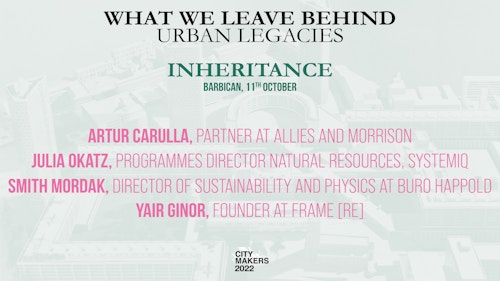/ Citymakers - What we leave behind, Urban Legacies: Inheritance
What do we leave behind? Well, just about everything.
Our annual masterplanning conference, Citymakers, returned for a fourth year in the autumn of 2022. Entitled ‘What we leave behind: Urban legacies’, the series encourages us to look back to the origins of modern urban development, and to consider the unique set of circumstances that led to the rapid speed of urbanisation seen in the latter half of the 20th century, and how that today forms a large part of our urban inheritance.
Introducing the first session at the Barbican Centre, an icon of post-war optimism, Artur Carulla discusses this transformational period up to the present day, asking whether we might now be in the midst of another urban paradigm shift.
Julia Okatz of innovation consultancy, SYSTEMIQ, shares insights of their forthcoming EU- funded white paper on the systemic issues facing the European city, advocating for efficient, balanced space use in European urban contexts. She presents a series of findings for application at the municipal level, emphasising how compact urban contexts are by far the most resource-efficient settlement types, allowing space for nature and low-carbon living. She looks at what this ‘efficiency’ means beyond density, and how we might leverage this compactness to create the vibrant neighbourhoods of tomorrow. Julia argues for a radical efficiency in our resource use of carbon-intensive construction materials, to have any hope of reaching climate targets.
Yair Ginor, founder at developer Frame [re], steps back to look at the bigger picture, raising questions that challenge some of our long-held assumptions. Yair approaches the idea of the urban legacy of housing from three angles: what are we taking with us from the last 75 years that isn’t beneficial? What are we at risk of not taking into the future? And what are we missing? He makes a point about how accumulated wealth, generated through a government-driven push for home ownership has perhaps gone too far, increasing wealth inequality and perpetuating a culture of NIMBYism. Challenging our assumptions, Yair asks, was homeownership well-intentioned but really a big mistake that we can’t escape?
Buro Happold’s Director of Sustainability, Smith Mordak, concludes with a fresh perspective on urbanism; comparing the composition of cities and their permanence to the rock cycle, as we demolish buildings and build anew in their place. They emphasise that although a cyclical process is at play, we create displacement but not extinction and must acknowledge that ultimately, everything is left behind.

